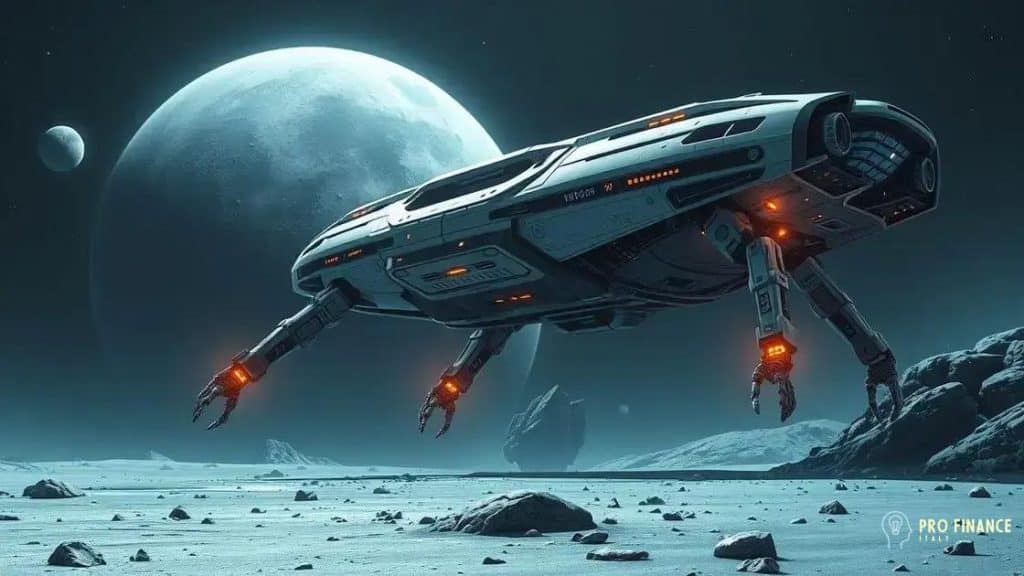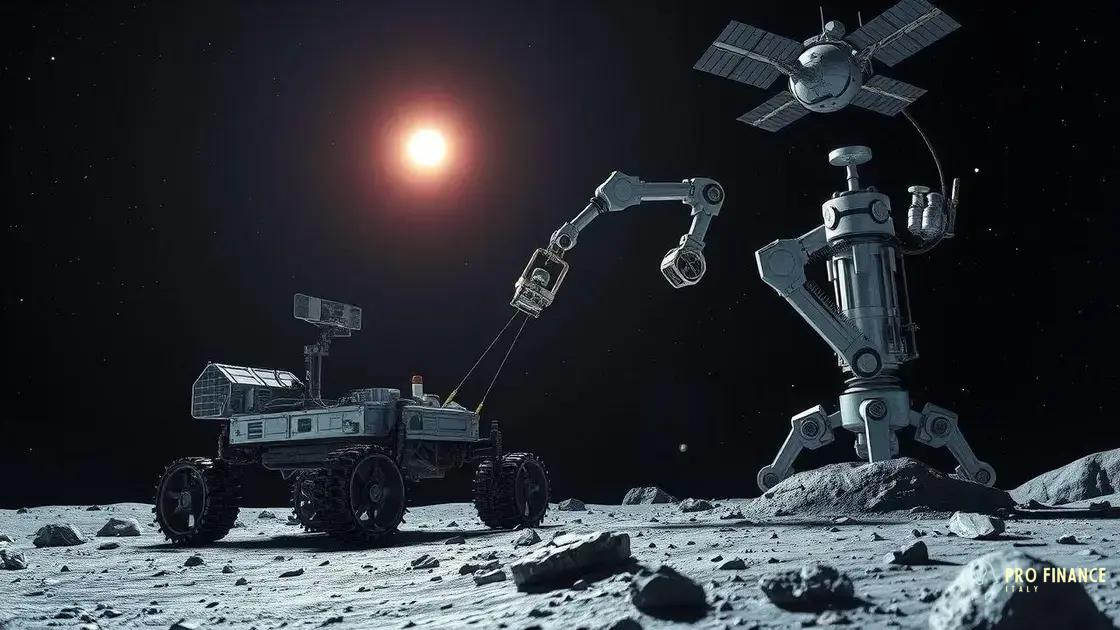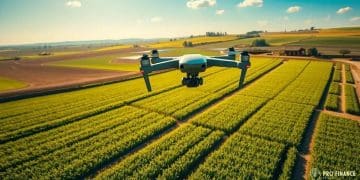The future of space exploration with AI and robotics

The future of space exploration with AI and robotics is focused on improving mission efficiency, enhancing data analysis, and enabling autonomous systems capable of operating in extreme environments.
The future of space exploration with AI and robotics is not just a concept; it’s quickly becoming a reality. As we look to the stars, the synergy between artificial intelligence and robotics can reshape our understanding of the universe. Have you ever wondered how these technologies work together to push the boundaries of exploration?
The role of AI in mission planning
In today’s advanced space endeavors, the role of AI in mission planning is fundamental. These technologies not only enhance our capabilities but also enable better decision-making during missions.
AI systems analyze a vast amount of data quickly, offering insights that humans might overlook. By processing historical mission data and real-time information, AI can predict outcomes and optimize strategies.
Enhanced Decision-Making
With AI, mission planners can simulate various scenarios. This helps in assessing potential risks and benefits, ensuring that every decision is made with comprehensive information.
- Predicting mission outcomes based on previous data
- Identifying optimal flight paths for spacecraft
- Assessing equipment reliability under different conditions
- Real-time adjustments based on live data
Moreover, AI can prioritize tasks, improving efficiency during critical mission phases. With automated systems handling minor decisions, astronauts can focus on more strategic elements. This not only increases the effectiveness of the missions but also allows teams to manage their time and resources wisely.
Real-Time Data Processing
The use of AI in mission planning allows for responsive actions. By processing data collected from sensors and instruments in real-time, AI can provide immediate feedback. This rapid response capability is crucial for adapting to unforeseen circumstances.
AI-driven systems can assess potential hazards, such as space debris or unpredictable environmental conditions. With real-time monitoring, mission planners can ensure safety and mission success.
As technology advances, the integration of AI into mission planning will only deepen, leading to more ambitious exploration strategies. The possibilities are endless, and we are just scratching the surface of what AI can accomplish in the realm of space exploration.
How robotics enhances space missions

The integration of robotics into space missions significantly enhances their capabilities. Robots are designed to perform tasks that are too dangerous or complex for humans, making them essential for exploration.
Robotic systems can operate in extreme environments, like the surfaces of other planets or deep space, where human presence is limited. This means they can gather valuable data and conduct experiments that would otherwise be impossible.
Types of Robotics Used in Space
Several types of robotic systems are employed in space missions. These systems include:
- Rovers: Mobile robots that navigate the surface of planets. They gather samples and send back data.
- Landers: Stationary robots that perform experiments and analyze soil and atmosphere.
- Orbiters: Robots that remain in orbit, capturing images and data from above.
- Robotic Arms: Used on spacecraft for manipulating objects or repairing systems.
Equipped with advanced sensors and AI, these robots are constantly improving in capability. They can communicate data back to Earth for analysis, allowing scientists to make informed decisions based on live feeds from space.
The Benefits of Robotics in Space Missions
One major advantage is the ability to conduct long-duration missions. Robots do not require life support systems, enabling them to operate indefinitely without the limitations faced by human crews. This continuous operation is critical for exploring distant planets.
Moreover, robots can work together in teams to enhance efficiency. By dividing tasks, they can complete missions faster and more effectively. This collaboration leads to more success in complex missions, such as those involving multiple objectives.
As robotics technology continues to evolve, we can expect even greater enhancements in future space missions. Understanding how these systems work is crucial for grasping the future of exploration beyond our planet.
Future spacecraft designs with AI
The future of spacecraft designs is increasingly influenced by the integration of AI. With advancements in technology, these designs are becoming more sophisticated, efficient, and capable of handling complex missions.
Incorporating AI into spacecraft allows for better data analysis and real-time decision-making. This means that future spacecraft can adapt to changing environments, optimizing their performance during exploration.
Key Features of AI-Enhanced Spacecraft
Future spacecraft will benefit from several key features:
- Autonomous Navigation: AI systems will enable spacecraft to navigate without constant input from mission control, making real-time adjustments as needed.
- Improved Communication: AI will enhance communication systems, allowing for faster data transmission and better analysis of information from space.
- Resource Management: AI can optimize the use of onboard resources, such as fuel and power, leading to longer missions and more efficient exploration.
- Self-Diagnostics: Future spacecraft will use AI for self-monitoring and troubleshooting, reducing the need for human oversight.
As these features become standard in spacecraft design, we can expect missions to reach new frontiers with greater ease. AI will allow spacecraft to explore more distant targets, such as the outer planets or even interstellar space.
Impact on Mission Objectives
The introduction of AI in spacecraft design will reshape mission objectives. With autonomous systems, missions can achieve multiple goals simultaneously. For instance, while a spacecraft is collecting data on a planetary surface, it can also monitor its own systems and send findings back to Earth.
This level of multitasking enhances the effectiveness of missions, allowing for a richer understanding of space. As we push the boundaries of our explorations, AI will be essential in coping with the challenges that arise.
In conclusion, the combination of advanced AI and innovative design will define the future of spacecraft, making them smarter and more efficient than ever before.
Challenges in integrating AI and robotics

The integration of AI and robotics in space exploration presents several challenges. These challenges can affect mission success and require careful consideration during planning and execution.
One significant challenge is the complexity of programming. Developing algorithms that allow robots to operate effectively in unpredictable environments is a daunting task. Engineers must ensure that these robots can adapt to varying conditions, which can be different on different celestial bodies.
Technical Limitations
Technical issues also crop up when integrating AI and robotics. Some of the key points include:
- Processing Power: AI systems require significant computing power to analyze data quickly. Spacecraft must have reliable systems that can handle this demand.
- Software Reliability: The software that drives these AI systems must be robust and bug-free to avoid failures during critical mission phases.
- Hardware Constraints: Spacecraft have limited weight and size allocations. Integrating advanced AI and robotic technologies must occur within these physical constraints.
- Power Management: High energy demands from AI-driven systems can strain the power resources of a spacecraft.
In addition to technical limitations, there are regulatory and ethical considerations. Deciding how much autonomy to give to robots can pose questions regarding control and decision-making during missions. Striking the right balance is essential.
Human Factors
Human factors also play a vital role in the integration process. Training astronauts to work alongside AI and robotic systems is crucial. They need to understand how these systems function and how to respond if things go wrong. Moreover, there may be concerns about job displacement within the space industry, as some tasks become automated.
As we move forward, addressing these challenges will be key to optimizing the use of AI and robotics in space missions. Success will depend on a collaborative effort between engineers, scientists, and astronauts to overcome hurdles and enhance the effectiveness of future explorations.
Real-world applications of AI in space
The real-world applications of AI in space are transforming how we explore and understand the universe. AI technologies are being employed in various phases of space missions, enhancing data collection, analysis, and operational efficiency.
One of the key areas where AI benefits space missions is in data analysis. Satellites and spacecraft gather enormous amounts of data from their environments. AI algorithms can process this data quickly, identifying patterns and anomalies that human analysts might miss. This rapid processing allows for timely decisions during missions.
Autonomous Systems
AI enables the development of autonomous systems, which are crucial for deep-space exploration. These systems can operate independently, making them ideal for missions where communication delays with Earth can occur. For instance, rovers like those on Mars use AI to navigate terrain and make decisions about where to explore next without waiting for instructions.
- Navigation: Autonomous navigation helps rovers and spacecraft chart their courses, avoiding obstacles during their journeys.
- Maintenance: AI systems can monitor spacecraft health and functionality, predicting potential failures and suggesting maintenance before problems arise.
- Scientific Discovery: AI assists in analyzing geological samples, detecting signs of past life, or identifying mineral compositions on other planets.
- Environmental Monitoring: AI is used in Earth observation satellites to track climate change and natural disasters.
This application of AI leads to significant advancements in our understanding of planetary systems. By automating complex tasks, scientists can focus on interpreting results and planning future explorations.
Enhanced Communication
Another important application is enhanced communication systems. AI improves data transmission between spacecraft and ground stations. With intelligent routing and error correction, communication becomes faster and more reliable. This capability is vital for real-time data sharing during missions.
Moreover, AI-driven systems can analyze incoming data on the fly, adjusting parameters for better clarity and detail. As we look to the future of space exploration, the integration of AI in real-world applications will continue to expand.
FAQ – Frequently Asked Questions about AI and Robotics in Space Exploration
How is AI used in mission planning?
AI helps in mission planning by analyzing data, predicting outcomes, and optimizing strategies for space missions.
What are the benefits of robotics in space missions?
Robotics enhances space missions by performing tasks that are too dangerous for humans and enabling autonomous operation in hostile environments.
What challenges do AI and robotics face in space?
Challenges include technical limitations, programming complexity, and ethical considerations regarding autonomy and decision-making.
How does AI improve communication in space missions?
AI enhances communication systems by routing data more efficiently and correcting errors, facilitating faster information exchange between spacecraft and Earth.





